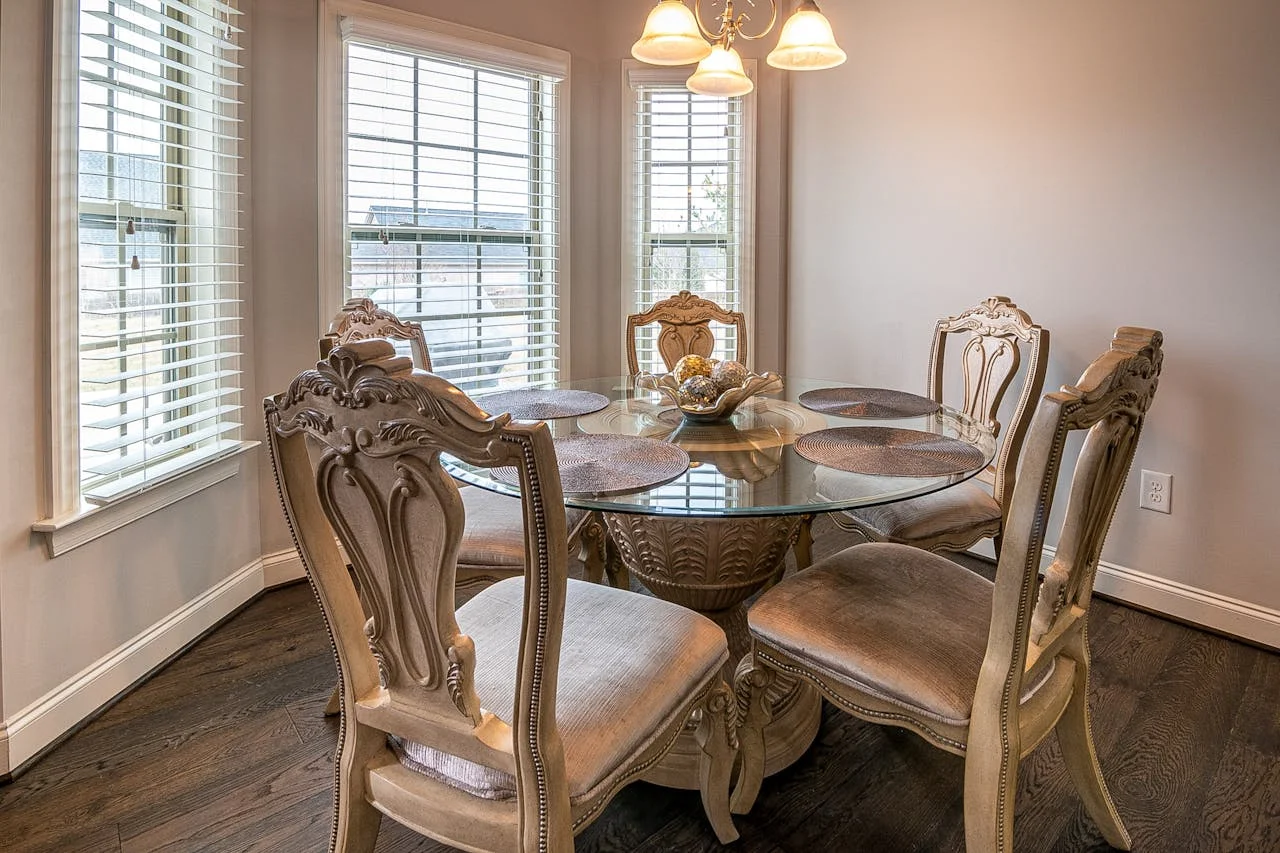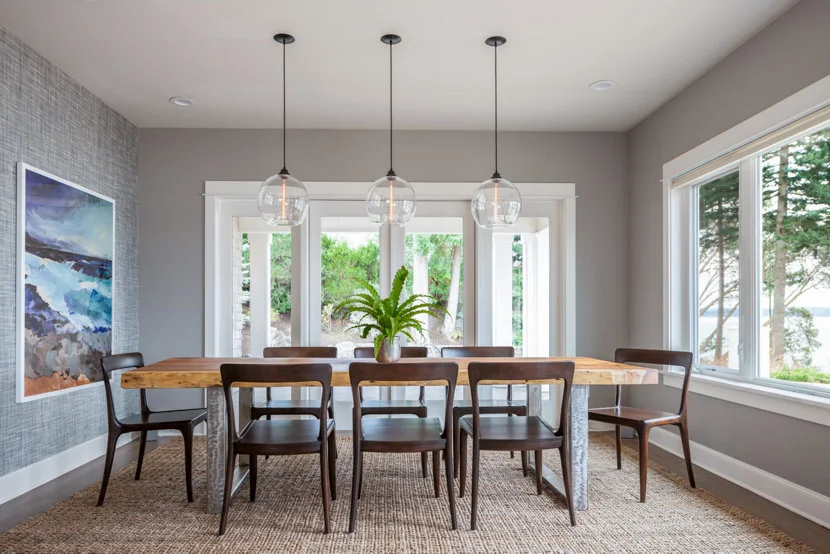Uncovering the History, Evolution, and Significance of Dining Rooms Every Designer Should Know!
When it comes to interior design, the dining room often gets overlooked. It’s seen as a functional space where meals are consumed, rather than a room that deserves attention and thought. But did you know that the dining room has a rich history and significant cultural significance?
In the realm of interior design, few spaces evoke as much warmth, conviviality, and tradition as the dining room. It serves as the heart of many homes, where families gather to share meals, stories, and laughter. But have you ever wondered about the origins of this cherished space? From Medieval feasting halls to Victorian parlors, the dining room has evolved to reflect changing societal norms and values. Read more...
 |
| Contemporary dining table with chairs, Photo by Curtis Adams |
In this blog, we will discover the history and significance of dining rooms, and explore how you can create a beautiful and inviting space for your meals and gatherings. Join us as we uncover the rich history and enduring significance of these cherished spaces where meals are shared and memories are made, and uncover the fascinating history of the dining room and its integral components.
History and Origin of Dining Room | When was the dining room invented?
The concept of a designated room for dining can be traced back to ancient civilizations, where communal eating spaces were common. However, the modern dining room as we know it today began to take shape during the Middle Ages in Europe.
Wealthy households during this period often had a separate room solely dedicated to dining, known as the "great hall" or "hall of state." These grand chambers were adorned with elaborate furnishings and served as prestigious settings for feasts and gatherings.

Follow the latest developments and news on our Google News website.
Follow Our WebsiteThe evolution of the dining table parallels the development of the dining room itself. In medieval times, tables were typically large, rectangular structures made of heavy wood and supported by trestles. As societal norms shifted and dining became more formalized, tables began to evolve into more refined pieces of furniture.
During the Renaissance, tables became status symbols, adorned with intricate carvings and ornate detailing. The Industrial Revolution brought about significant changes in dining table design, with the mass production of furniture leading to greater accessibility and affordability. This era saw the rise of various styles, from the elegant curves of the Victorian era to the sleek lines of the Art Deco movement.
FAQ 1- What is the Reason for Creating a Dining Room?
Beyond its practical function as a space for eating, the dining room serves a multitude of purposes. It acts as a hub for social interaction, providing a setting for gatherings, celebrations, and intimate conversations. In many cultures, sharing a meal is viewed as a bonding experience, fostering connections and strengthening relationships.
Additionally, it often serves as a reflection of personal style and taste. Through carefully selecting furniture, lighting, and decor, homeowners can create an inviting and aesthetically pleasing space. Whether it's a formal dinner party or a casual family meal, the dining room's ambiance sets the stage for memorable experiences.
FAQ 2- What Does the Dining Room Symbolize?
The dining room holds symbolic significance in many cultures and traditions. It represents hospitality, generosity, and the joy of communal living. In some societies, the dining table is regarded as sacred, symbolizing unity and harmony among family members.
Furthermore, it can serve as a showcase for cultural heritage and culinary traditions. From traditional holiday feasts to everyday rituals, the dining space plays a central role in preserving and passing down customs from one generation to the next.
FAQ 3- What are the Common Dining Room Design Mistakes To Avoid?
Designing a dining space can be an exciting endeavor, but it's not without its challenges. From layout mishaps to lighting faux pas, there are several common mistakes that homeowners often make when styling this essential area. In this FAQ, we'll explore some of these blunders and provide expert tips on how to avoid them, ensuring that your dining room becomes a haven of style and functionality.
Neglecting Proper Lighting:
One of the most prevalent mistakes is inadequate or improper lighting. A poorly lit dining area can create a dull and uninviting atmosphere, detracting from the overall dining experience. Whether it's overly harsh overhead lighting or insufficient ambient lighting, finding the right balance is crucial.
Opt for a combination of overhead fixtures, such as chandeliers or pendant lights, along with task lightings, such as wall sconces or table lamps, to create layers of illumination that can be adjusted according to different occasions.
 |
| Pendant lights can help solve the lack of luminance, Photo: goldberg-home.com |
Oversized or Undersized Furniture:
Another common error is choosing dining furniture that is either too large or too small for the space. Oversized tables and chairs can overwhelm a room, making it feel cramped and impractical for everyday use. On the other hand, undersized furniture can leave the space feeling sparse and disproportionate.Before purchasing dining furniture, carefully measure your dining area and consider the scale of the room. Opt for pieces that are proportionate to the space while still allowing for comfortable seating and ease of movement. Read more...
Ignoring the Flow of Traffic:
A well-designed dining room should have a logical flow of traffic, allowing guests to move freely between the dining area and adjacent spaces. However, failing to consider traffic flow can result in cramped and awkward layouts that impede movement.
Avoid placing furniture or fixtures in high-traffic areas, such as pathways to the kitchen or entryways. Instead, create clear pathways that guide guests to and from the dining table without obstruction. Read more...
These are only some of the common mistakes that homeowners make when designing their dining room; Ask your decor expert for more mistakes that you can avoid, according to your home style and other dependencies.
By avoiding these, you can create a space that is not only visually stunning but also functional and conducive to enjoyable dining experiences.
Remember to prioritize proper lighting, choose appropriately sized furniture, consider traffic flow, personalize the space, and address acoustic concerns to ensure that your dining room is a welcoming and harmonious environment for gatherings with family and friends.
In contemporary interior design, the dining room continues to evolve, adapting to changing lifestyles and preferences. From open-concept layouts to multifunctional spaces, today's dining rooms reflect a blend of tradition and innovation.
Last but not least, the history of the dining room is a testament to the enduring importance of communal dining and shared experiences. From its humble beginnings in medieval Europe to its present-day incarnation as a centerpiece of modern living, the dining room remains a cherished space where memories are made and traditions are honored. As we look to the future, let us continue to celebrate the timeless appeal of the dining room and the timeless rituals it embodies.

